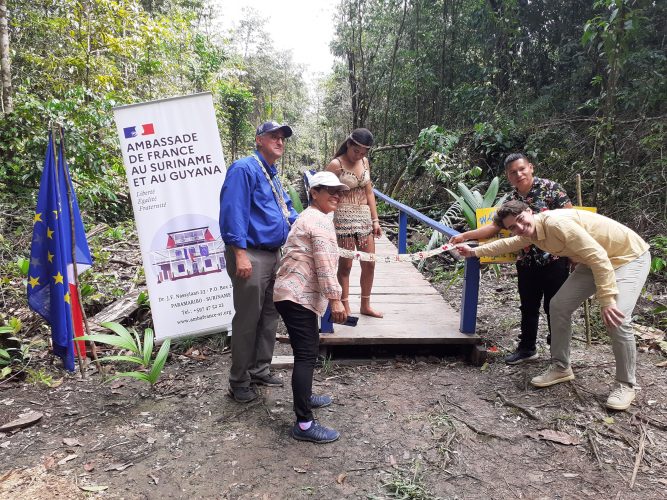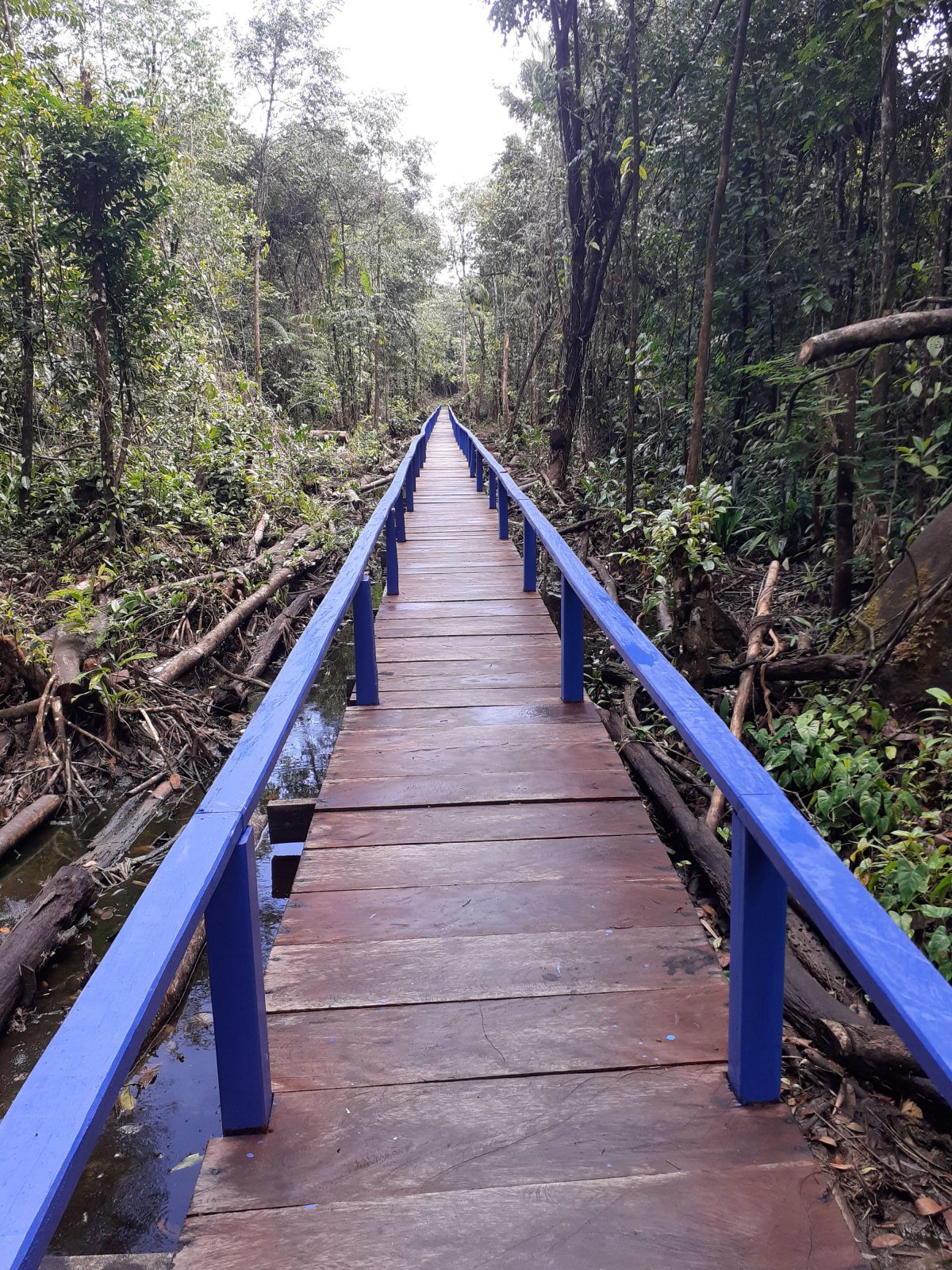Residents of Warapoka in the north west will now be able to further promote eco-tourism in their community while also having easier access to their farmlands, as a 500-foot bridge spanning a bothersome swamp was on Sunday commissioned by the Amerindian People’s Association (APA) in collaboration with the French government.
Warapoka, which is located in the Moruca sub-district of Barima-Waini in Region One, and home to approximately 700 residents, has for the first time ever, witnessed the construction of the ‘Troolie Hill’ Bridge which was funded by the French Government at a cost of $4,095,060 through the APA’s Solidarity Fund for Innovative Projects (SFIP) initiative.
At the small commissioning which was held at the site of the bridge on Sunday, Jaremy Boyal, toshao of the Indigenous community explained to the media that the main purpose of the bridge is to boost their recently launched eco-tourism package which includes bird-watching for harpy eagles and their nests which are prominent in the area. He added that the bridge will not only assist in their tourism efforts, but will also bring a measure of relief to many farmers who cultivate and harvest their products in Troolie Hill.


He said that no bridge was ever built in that area before and for many decades villagers used to walk in the swamp or sometimes would place logs lengthwise to get over to the other side.
“…This is a swamp and so for many years farmers who traverse this area would have a difficult time walking across the swamp on logs, so this was one of our priority projects that we’ve had in mind, so APA was there (and) came up and said ‘we have funding through French Government’ and I was like ‘wow this is the opportunity we need to take advantage of.’”
The toshao added, “Now the direct benefit is tourism, the business that we’re doing, [as] guests will now have easy access. Farmers, women, children, who traverse this area to do their farming, they will now have accident- free crossing, so it’s something not only for tourism… but it improves the access to farm lands as well… The average amount is twelve families that are farming here presently so with that, roughly about forty people will directly benefit… besides that we have hunters as well who would go to hunt, fish, so the benefit for the village generally is very wide, economically, as well as socially.”
Works for the project which consisted of training for some of the residents had commenced on October 3 of last year and full construction of the bridge ended on December 27 of the same year. The toshao noted that construction lasted for about six weeks and used only labour supplied by Warapoka’s residents. The Mora logs used were harvested from near the construction site.
“The construction actually took six weeks…from cutting the materials to bringing it to site and directly constructing it, it’s made from Mora found right here in Warapoka, very good wood for construction and can withstand any weather… they were able to do training with us, with a group, a community that oversaw and managed the project as well. The village council oversaw the entire project as well, but the labourers and all the work was done by residents, we had more than thirty people who worked here,” Boyal informed.
Meanwhile, as it relates to the community’s tourism drive, Boyal noted that since it was only recently launched, for the past year they have had only about ninety tourists who were mostly internationally based. He said the reason that most of the tourists are non-Guyanese is due to the travel costs which make the package very expensive.
As it pertains to their tour package, besides having bird-watching as its main attraction, he said that other activities which are offered to tourists while in Warapoka include, learning to craft various Amerindian artifacts and making traditional coffee by picking the seeds directly from the plants and drying them, along with using coconut milk in the coffee beverage or other tea-like beverages, and fishing. The toshao noted that although he is not sure about the harpy eagle population, three nests have been identified within a five-mile radius so far.
“Normally what we would do is we would pick the coffee, allow it to dry in the sun, sometimes we would boil it to take off the pulp, then we would use a ‘karahi’[traditional type of circular pan similar to a wok] on the fire, some people would add like sugar-cane juice to it as well of cane juice, but now people just add sugar… so that’s something we want to show our guests how we’ve done it traditionally instead of [as is done] now,” explained the man.
He mentioned that so far they have had persons from various tourism organisations helping them and training members of the community in aspects such as tour guiding, birding, first aiding, and much more. They have also partnered with these organisations and other tour operators to generate customers.
Constant rise
One of the residents, Carleen Wilson, who was trained in proposal writing by the APA and was appointed as Project Manager for the construction of the bridge, told the gathering that the only challenge that they faced was the constant rise in the water level. “Carrying out the project, the only challenge we faced was the water level, the rain fell a lot during that time causing the water to raise high but we managed to overcome that.”
Giving a breakdown of what the training entailed, Executive Director of the APA, Jean La Rose said, “This project started with training, we worked with a group of four people to first understand how to do proposal writing, how to do budgeting, then how to do reporting for the work that you do… it took some time to sit in a classroom setting, to read a manual, to understand a manual, to follow the manual… it’s entirely a community activity, nobody came in to design the bridge, they did that themselves, they went into the mud and the swamp and they cut the logs that were necessary and so forth.”
La Rose said that SFIP focusses on capacity building, advocacy, livelihoods, and the protection of forests, and as such that was why the training was necessary and the reason why the specific project for the area was chosen.
Present at the commissioning were two representatives of the French government, French Honorary Consul, Jean-Francois Gerin, and Resident Representative of the French Embassy in Guyana, Pierre Gate. They both congratulated the residents on their achievement and promised them further support.
As they traversed the bridge with much delight and with even tears in their eyes, two of the residents expressed to Stabroek News how grateful they were for the bridge.
“We use to had to walk in the swamp… sometimes we does gat we cutlass passing and sometimes we fall and hurt we self. One of my sister was passing with she cutlass and the cutlass fall by she leg and she lucky she barely get a cut or else it could’ve been more dangerous… it gat the electric eel and dah use to shock we up… sometimes when it shock from distance you does get the feeling and you could fall overboard and they could climb pon you and shock you up even more,” said a relieved 57-year-old Theresa Bascom.
Bascom said that she has been farming since she was 30 years old and now she’s happy that she and other farmers could walk in ease to get to their farmlands. The woman usually plants cassava, watermelon, eddoes and many more fruits, ground provisions, and vegetables.
Paula Wilson, 59, said that she had previously been farming in the main areas of Warapoka and had recently located some farmland in Troolie Hill due to the fertile soil in that area. “I was farming mostly down here [while pointing to the area where she was standing] but now I come to over here [pointing across the bridge] where we call Troolie Hill because I see the crops are improving, like the bitter cassava, pineapples, banana, plantain, yam… I’m happy because during the first time it was very dangerous when water would flood the place and we didn’t had no proper place to walk, so it was very dangerous to cross when the water was high… so it doing a great help to us doing the farming and most people coming across now to do the farming over here [Troolie Hill].”






